2017 NISSAN ALTIMA Fuel filter
[x] Cancel search: Fuel filterPage 471 of 497
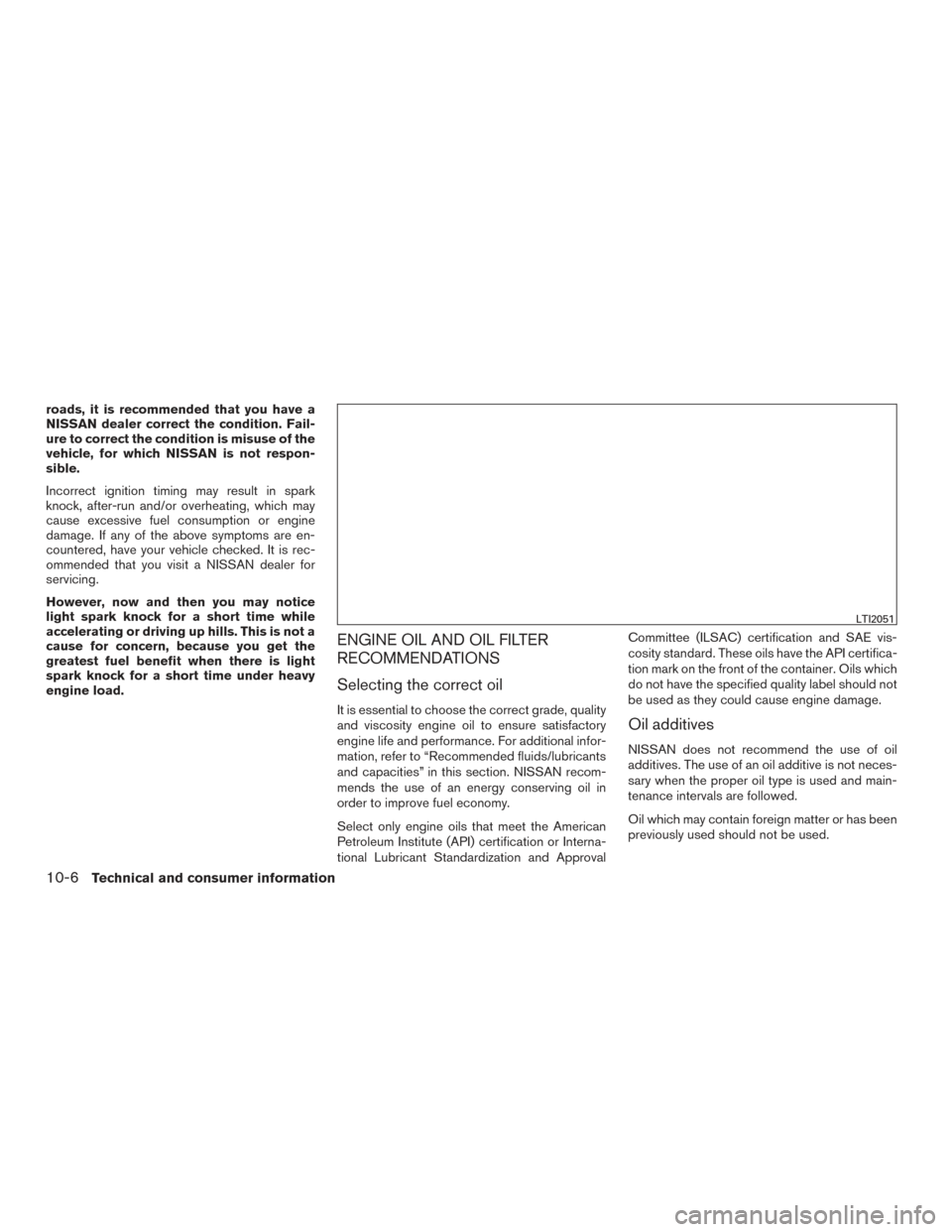
roads, it is recommended that you have a
NISSAN dealer correct the condition. Fail-
ure to correct the condition is misuse of the
vehicle, for which NISSAN is not respon-
sible.
Incorrect ignition timing may result in spark
knock, after-run and/or overheating, which may
cause excessive fuel consumption or engine
damage. If any of the above symptoms are en-
countered, have your vehicle checked. It is rec-
ommended that you visit a NISSAN dealer for
servicing.
However, now and then you may notice
light spark knock for a short time while
accelerating or driving up hills. This is not a
cause for concern, because you get the
greatest fuel benefit when there is light
spark knock for a short time under heavy
engine load.
ENGINE OIL AND OIL FILTER
RECOMMENDATIONS
Selecting the correct oil
It is essential to choose the correct grade, quality
and viscosity engine oil to ensure satisfactory
engine life and performance. For additional infor-
mation, refer to “Recommended fluids/lubricants
and capacities” in this section. NISSAN recom-
mends the use of an energy conserving oil in
order to improve fuel economy.
Select only engine oils that meet the American
Petroleum Institute (API) certification or Interna-
tional Lubricant Standardization and ApprovalCommittee (ILSAC) certification and SAE vis-
cosity standard. These oils have the API certifica-
tion mark on the front of the container. Oils which
do not have the specified quality label should not
be used as they could cause engine damage.Oil additives
NISSAN does not recommend the use of oil
additives. The use of an oil additive is not neces-
sary when the proper oil type is used and main-
tenance intervals are followed.
Oil which may contain foreign matter or has been
previously used should not be used.
LTI2051
10-6Technical and consumer information
Page 489 of 497
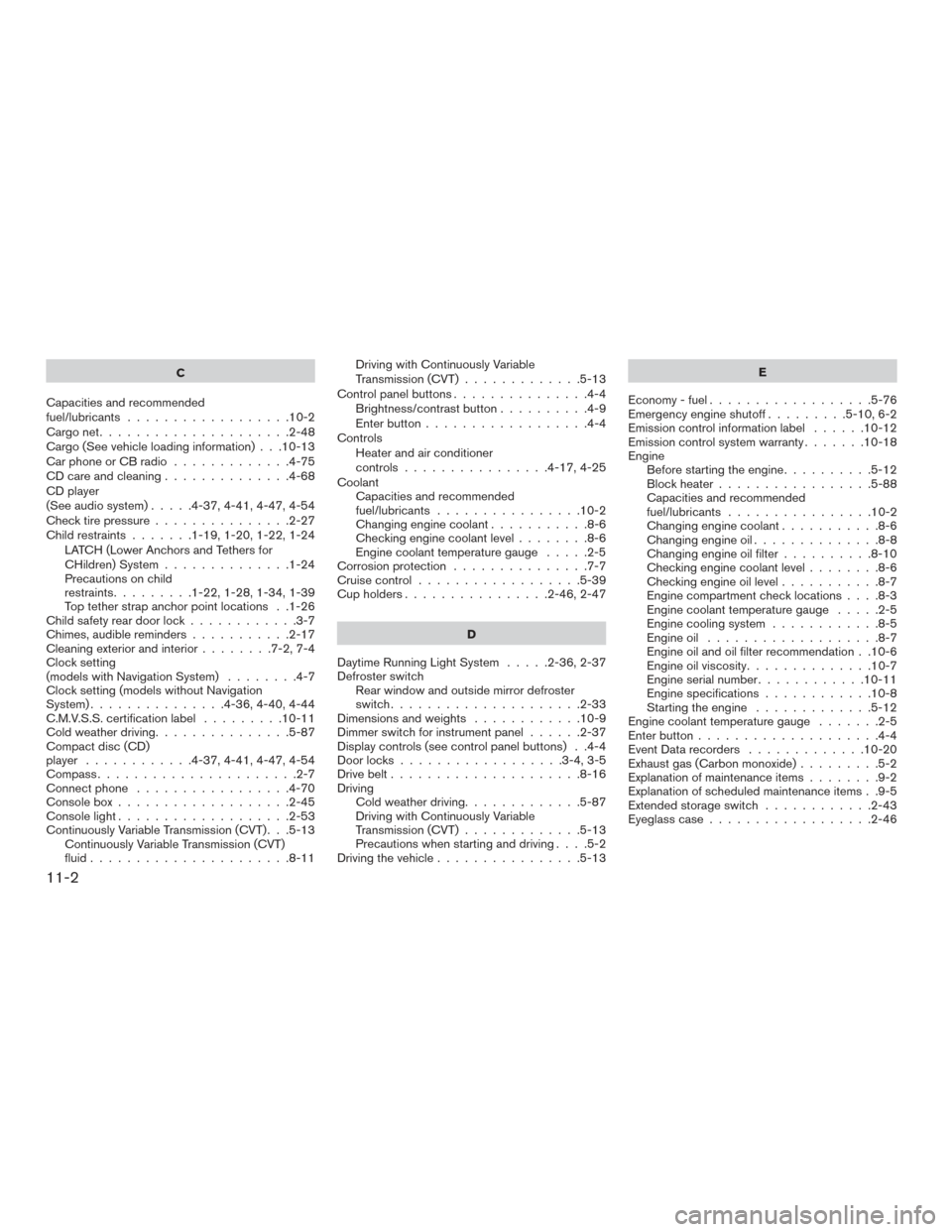
C
Capacities and recommended
fuel/lubricants ..................10-2
Cargonet.....................2-48
Cargo (See vehicle loading information) . . .10-13
Car phone or CB radio .............4-75
CD care and cleaning ..............4-68
CD player
(See audio system) .....4-37,4-41,4-47,4-54
Check tire pressure ...............2-27
Child restraints .......1-19,1-20,1-22,1-24
LATCH (Lower Anchors and Tethers for
CHildren) System ..............1-24
Precautions on child
restraints.........1-22,1-28,1-34,1-39
Top tether strap anchor point locations . .1-26
Child safety rear door lock ............3-7
Chimes, audible reminders ...........2-17
Cleaningexteriorandinterior........7-2,7-4
Clock setting
(models with Navigation System) ........4-7
Clock setting (models without Navigation
System) ...............4-36,4-40,4-44
C.M.V.S.S. certification label .........10-11
Cold weather driving ...............5-87
Compact disc (CD)
player ............4-37,4-41,4-47,4-54
Compass ......................2-7
Connect phone .................4-70
Consolebox...................2-45
Consolelight...................2-53
Continuously Variable Transmission (CVT) . . .5-13 Continuously Variable Transmission (CVT)
fluid ......................8-11 Driving with Continuously Variable
Transmission (CVT)
.............5-13
Control panel buttons ...............4-4
Brightness/contrast button ..........4-9
Enterbutton..................4-4
Controls Heater and air conditioner
controls................4-17,4-25
Coolant Capacities and recommended
fuel/lubricants ................10-2
Changingenginecoolant...........8-6
Checking engine coolant level ........8-6
Engine coolant temperature gauge .....2-5
Corrosion protection ...............7-7
Cruisecontrol..................5-39
Cupholders................2-46,2-47
D
Daytime Running Light System .....2-36,2-37
Defroster switch Rear window and outside mirror defroster
switch.....................2-33
Dimensionsandweights ............10-9
Dimmer switch for instrument panel ......2-37
Display controls (see control panel buttons) . .4-4
Door locks ..................3-4,3-5
Drive belt .....................8-16
Driving Cold weather driving .............5-87
Driving with Continuously Variable
Transmission (CVT) .............5-13
Precautions when starting and driving ....5-2
Driving the vehicle ................5-13 E
Economy-fuel..................5-76
Emergency engine shutoff .........5-10,6-2
Emission control information label ......10-12
Emission control system warranty .......10-18
Engine Before starting the engine ..........5-12
Blockheater.................5-88
Capacities and recommended
fuel/lubricants ................10-2
Changing engine coolant ...........8-6
Changingengineoil..............8-8
Changing engine oil filter ..........8-10
Checking engine coolant level ........8-6
Checking engine oil level ...........8-7
Engine compartment check locations ....8-3
Engine
coolant temperature gauge .....2-5
Engine cooling system ............8-5
Engineoil ...................8-7
Engine oil and oil filter recommendation . .10-6
Engine oil viscosity ..............10-7
Engine serial number ............10-11
Engine specifications ............10-8
Starting the engine .............5-12
Engine coolant temperature gauge .......2-5
Enter button ....................4-4
Event Data recorders .............10-20
Exhaust gas (Carbon monoxide) .........5-2
Explanation of maintenance items ........9-2
Explanation of scheduled maintenance items . .9-5
Extended storage switch ............2-43
Eyeglass case ..................2-46
11-2
Page 490 of 497
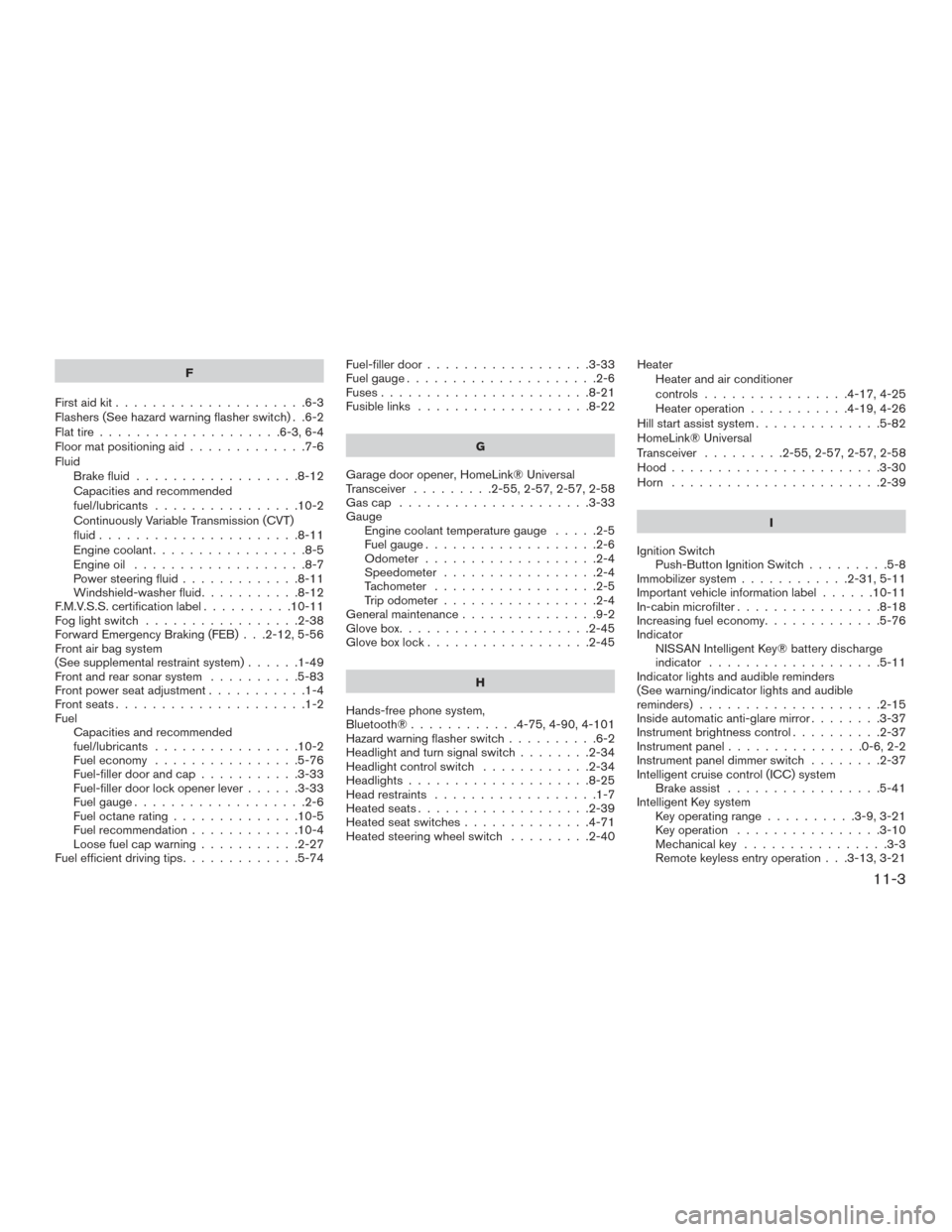
F
First aid kit .....................6-3
Flashers (See hazard warning flasher switch) . .6-2
Flat tire ....................6-3,6-4
Floor mat positioning aid .............7-6
Fluid Brake fluid ..................8-12
Capacities and recommended
fuel/lubricants ................10-2
Continuously Variable Transmission (CVT)
fluid......................8-11
Engine coolant .................8-5
Engine oil ...................8-7
Power steering fluid .............8-11
Windshield-washerfluid...........8-12
F.M.V.S.S. certification label ..........10-11
Foglightswitch .................2-38
Forward Emergency Braking (FEB) . . .2-12, 5-56
Front air bag system
(See supplemental restraint system) ......1-49
Front and rear sonar system ..........5-83
Front power seat adjustment ...........1-4
Frontseats.....................1-2
Fuel Capacities and recommended
fuel/lubricants ................10-2
Fuel economy ................5-76
Fuel-filler door and cap ...........3-33
Fuel-filler door lock opener lever ......3-33
Fuel gauge ...................2-6
Fuel octane rating ..............10-5
Fuel recommendation ............10-4
Loose fuel cap warning ...........2-27
Fuel efficient driving tips .............5-74 Fuel-filler door
..................3-33
Fuelgauge.....................2-6
Fuses.......................8-21
Fusiblelinks ...................8-22
G
Garage door opener, HomeLink® Universal
Transceiver .........2-55,2-57,2-57,2-58
Gascap .....................3-33
Gauge Engine coolant temperature gauge .....2-5
Fuel gauge ...................2-6
Odometer ...................2-4
Speedometer .................2-4
Tachometer ..................2-5
Trip odometer .................2-4
General maintenance ...............9-2
Glovebox.....................2-45
Gloveboxlock..................2-45
H
Hands-free phone system,
Bluetooth®............4-75,4-90,4-101
Hazard warning flasher switch ..........6-2
Headlight and turn signal switch ........2-34
Headlight control switch ............2-34
Headlights ....................8-25
Head restraints ..................1-7
Heated seats ...................2-39
Heated seat switches ..............4-71
Heated steering wheel switch .........2-40Heater
Heater and air conditioner
controls ................4-17,4-25
Heater operation ...........4-19,4-26
Hill start assist system ..............5-82
HomeLink® Universal
Transceiver .........2-55,2-57,2-57,2-58
Hood.......................3-30
Horn .......................2-39
I
Ignition Switch Push-Button Ignition Switch .........5-8
Immobilizer system ............2-31,5-11
Important vehicle information label ......
10-11
In-cabin microfilter ................8-18
Increasing fuel economy .............5-76
Indicator NISSAN Intelligent Key® battery discharge
indicator ...................5-11
Indicator lights and audible reminders
(See warning/indicator lights and audible
reminders)....................2-15
Inside automatic anti-glare mirror ........3-37
Instrument brightness control ..........2-37
Instrumentpanel...............0-6,2-2
Instrument panel dimmer switch ........2-37
Intelligent cruise control (ICC) system Brake assist .................5-41
Intelligent Key system Key operating range ..........3-9,3-21
Key operation ................3-10
Mechanical key ................3-3
Remote keyless entry operation . . .3-13, 3-21
11-3
Page 492 of 497
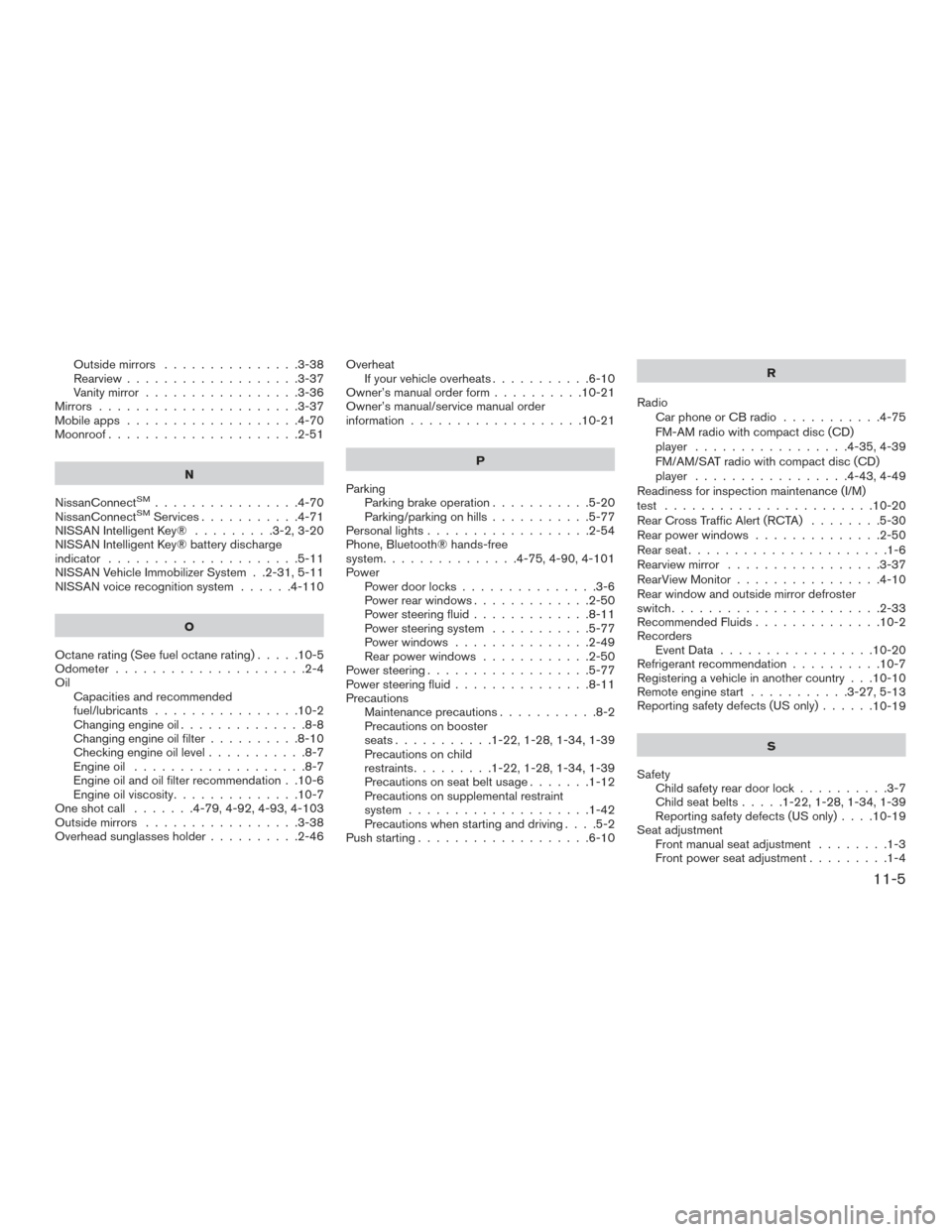
Outside mirrors...............3-38
Rearview ...................3-37
Vanity mirror .................3-36
Mirrors ......................3-37
Mobileapps ...................4-70
Moonroof .....................2-51
N
NissanConnect
SM................4-70
NissanConnectSMServices...........4-71
NISSAN Intelligent Key® .........3-2,3-20
NISSAN Intelligent Key® battery discharge
indicator .....................5-11
NISSAN Vehicle Immobilizer System . .2-31, 5-11
NISSAN voice recognition system ......4-110
O
Octanerating(Seefueloctanerating).....10-5
Odometer .....................2-4
Oil Capacities and recommended
fuel/lubricants ................10-2
Changing engine oil ..............8-8
Changing engine oil filter ..........8-10
Checking engine oil level ...........8-7
Engine oil ...................8-7
Engine oil and oil filter recommendation . .10-6
Engine oil viscosity ..............10-7
Oneshotcall .......4-79,4-92,4-93,4-103
Outside mirrors .................3-38
Overhead sunglasses holder ..........2-46Overheat
If your vehicle overheats ...........6-10
Owner’s manual order form ..........10-21
Owner’s manual/service manual order
information ...................10-21
P
Parking Parking brake operation ...........5-20
Parking/parking on hills ...........5-77
Personallights..................2-54
Phone, Bluetooth® hands-free
system ...............4-75,4-90,4-101
Power Power door locks ...............3-6
Power rear windows .............2-50
Power steering fluid .............8-11
Power steering system ...........5-77
Power windows ...............2-49
Rear power windows ............2-50
Power steering ..................5-77
Power steering fluid ...............8-11
Precautions Maintenance precautions ...........8-2
Precautions on booster
seats...........1-22,1-28,1-34,1-39
Precautions on child
restraints .........1-22,1-28,1-34,1-39
Precautions on seat belt usage .......1-12
Precautions on supplemental restraint
system ....................1-42
Precautions when starting and driving ....5-2
Push starting ...................6-10 R
Radio CarphoneorCBradio ...........4-75
FM-AM radio with compact disc (CD)
player .................4-35,4-39
FM/AM/SAT radio with compact disc (CD)
player .................4-43,4-49
Readiness for inspection maintenance (I/M)
test .......................10-20
Rear Cross Traffic Alert (RCTA) ........5-30
Rear power windows ..............2-50
Rearseat......................1-6
Rearview mirror .................3-37
RearView Monitor ................4-10
Rear window and outside mirror defroster
switch.......................2-33
Recommended Fluids ..............10-2
Recorders EventData .................10-20
Refrigerant recommendation ..........10-7
Registering a vehicle in another country . . .10-10
Remote engine start ...........3-27,5-13
Reporting safety defects (US only) ......
10-19
S
Safety Child safety rear door lock ..........3-7
Child seat belts .....1-22,1-28,1-34,1-39
Reporting safety defects (US only) ....10-19
Seat adjustment Front manual seat adjustment ........1-3
Front power seat adjustment .........1-4
11-5
Page 496 of 497
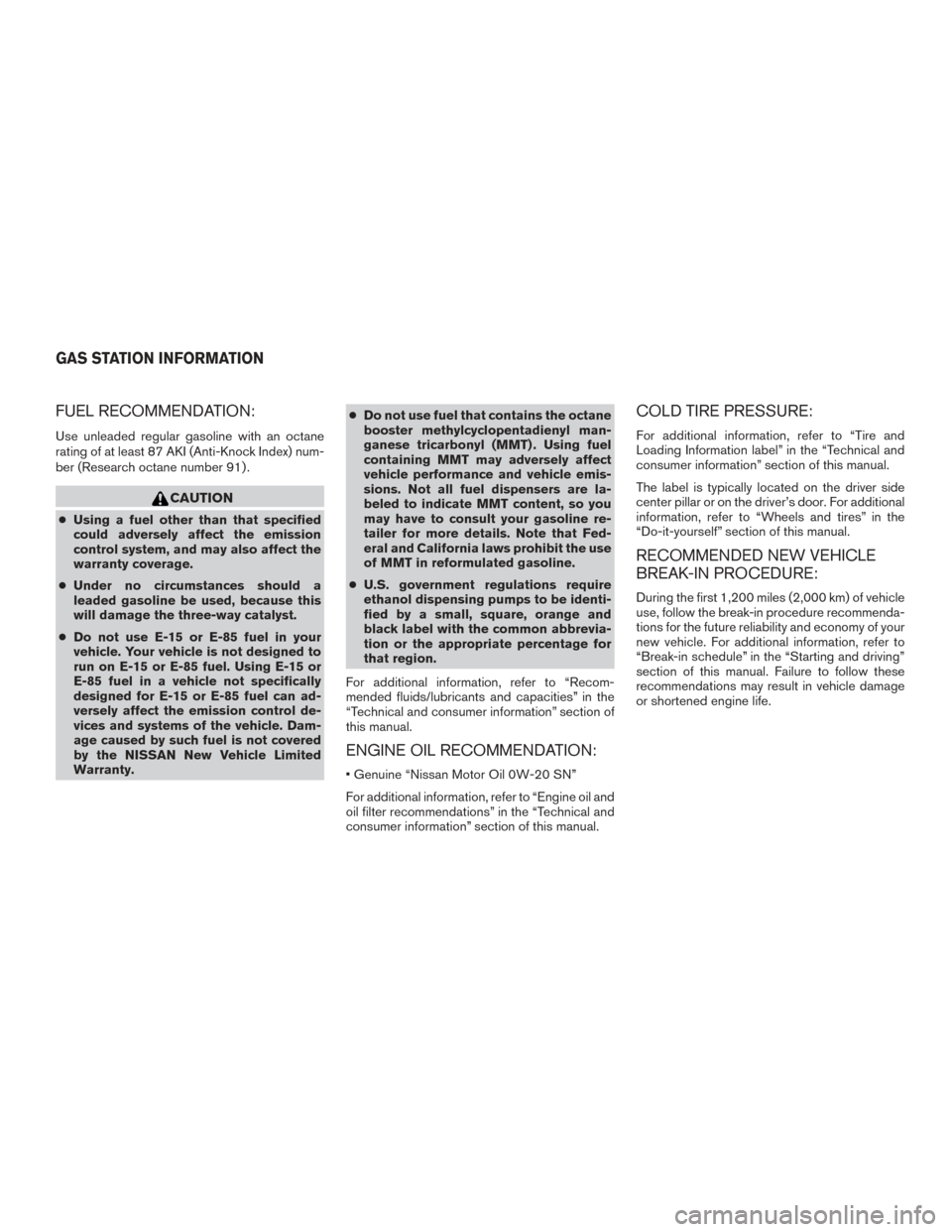
FUEL RECOMMENDATION:
Use unleaded regular gasoline with an octane
rating of at least 87 AKI (Anti-Knock Index) num-
ber (Research octane number 91) .
CAUTION
●Using a fuel other than that specified
could adversely affect the emission
control system, and may also affect the
warranty coverage.
● Under no circumstances should a
leaded gasoline be used, because this
will damage the three-way catalyst.
● Do not use E-15 or E-85 fuel in your
vehicle. Your vehicle is not designed to
run on E-15 or E-85 fuel. Using E-15 or
E-85 fuel in a vehicle not specifically
designed for E-15 or E-85 fuel can ad-
versely affect the emission control de-
vices and systems of the vehicle. Dam-
age caused by such fuel is not covered
by the NISSAN New Vehicle Limited
Warranty. ●
Do not use fuel that contains the octane
booster methylcyclopentadienyl man-
ganese tricarbonyl (MMT) . Using fuel
containing MMT may adversely affect
vehicle performance and vehicle emis-
sions. Not all fuel dispensers are la-
beled to indicate MMT content, so you
may have to consult your gasoline re-
tailer for more details. Note that Fed-
eral and California laws prohibit the use
of MMT in reformulated gasoline.
● U.S. government regulations require
ethanol dispensing pumps to be identi-
fied by a small, square, orange and
black label with the common abbrevia-
tion or the appropriate percentage for
that region.
For additional information, refer to “Recom-
mended fluids/lubricants and capacities” in the
“Technical and consumer information” section of
this manual.
ENGINE OIL RECOMMENDATION:
• Genuine “Nissan Motor Oil 0W-20 SN”
For additional information, refer to “Engine oil and
oil filter recommendations” in the “Technical and
consumer information” section of this manual.
COLD TIRE PRESSURE:
For additional information, refer to “Tire and
Loading Information label” in the “Technical and
consumer information” section of this manual.
The label is typically located on the driver side
center pillar or on the driver’s door. For additional
information, refer to “Wheels and tires” in the
“Do-it-yourself” section of this manual.
RECOMMENDED NEW VEHICLE
BREAK-IN PROCEDURE:
During the first 1,200 miles (2,000 km) of vehicle
use, follow the break-in procedure recommenda-
tions for the future reliability and economy of your
new vehicle. For additional information, refer to
“Break-in schedule” in the “Starting and driving”
section of this manual. Failure to follow these
recommendations may result in vehicle damage
or shortened engine life.
GAS STATION INFORMATION